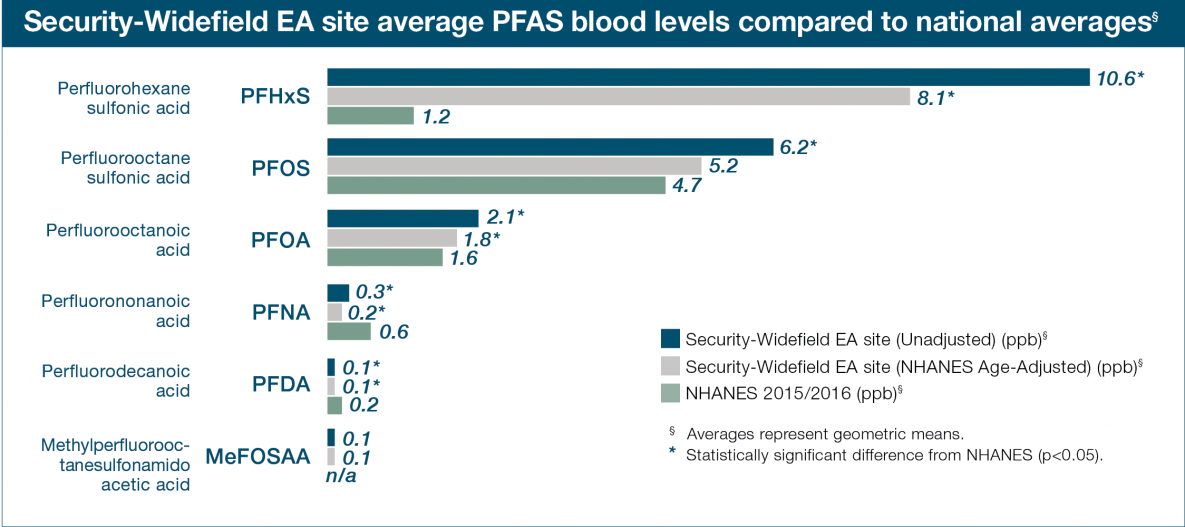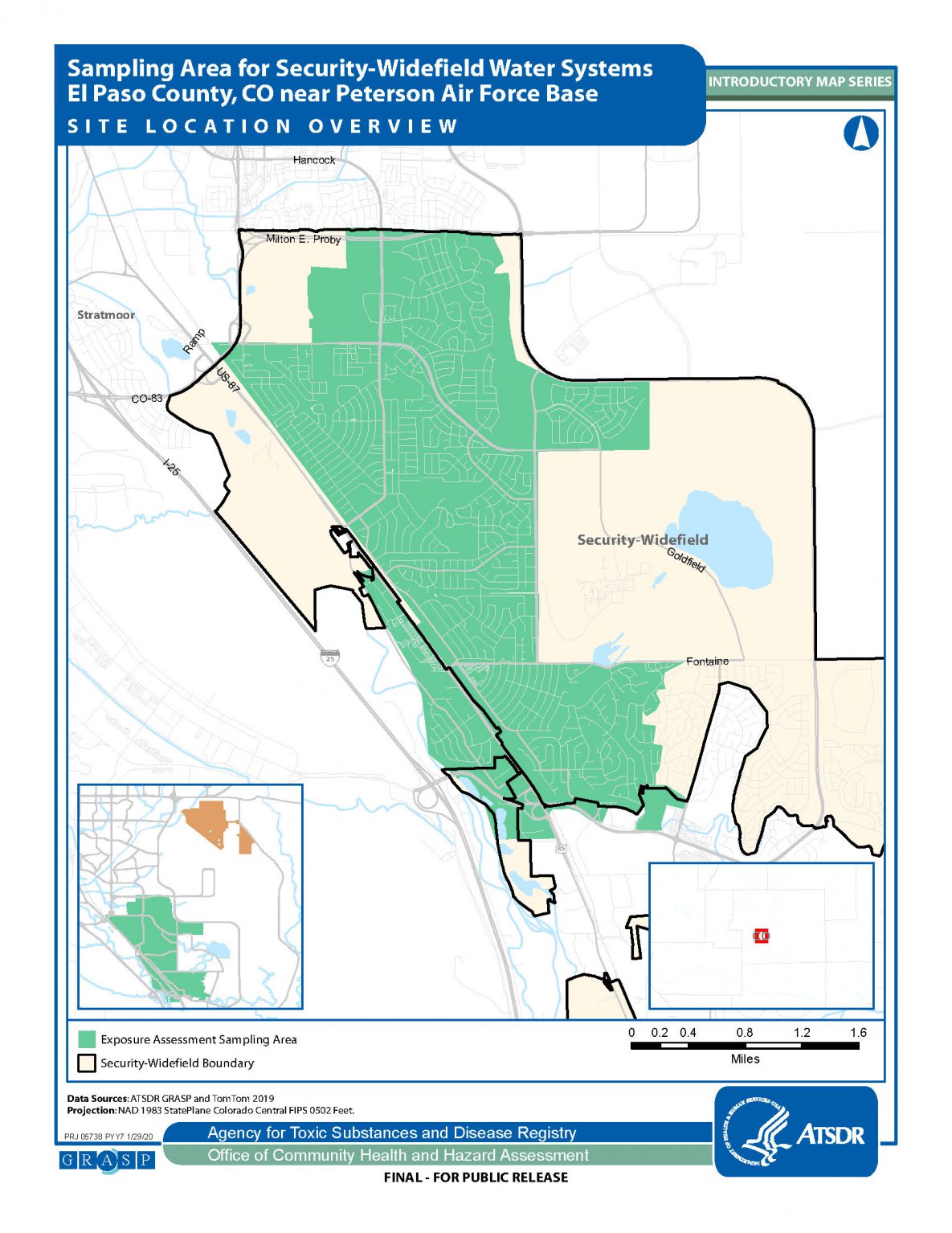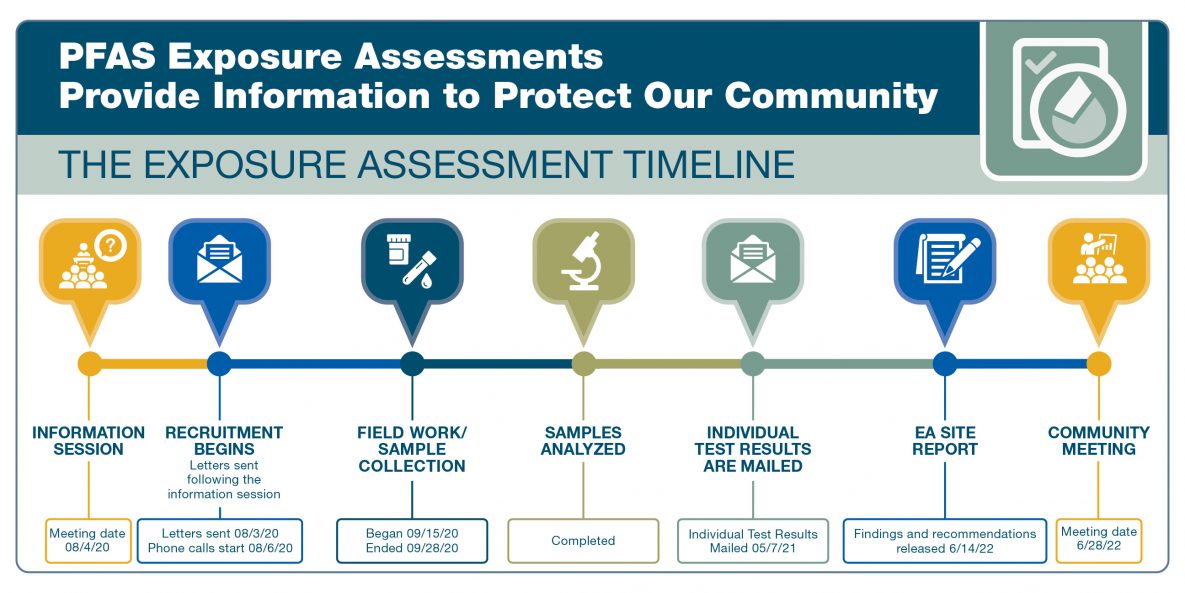El Paso County (CO) near Peterson Air Force Base

Background
In 2020, The Centers for Disease Control and Prevention (CDC) and the Agency for Toxic Substances and Disease Registry (ATSDR) conducted an exposure assessment (EA) in Security-Widefield, El Paso County, Colorado, near Peterson Air Force Base. CDC and ATSDR sent the individual test results to participants and released summary results to the community in May 2021. The per- and polyfluoroalkyl substances (PFAS) exposure assessment report [PDF – 3 MB] was released in June 2022.
In 2019, CDC/ATSDR established a cooperative agreement with researchers at the Colorado School of Public Health (Colorado SPH), at the University of Colorado Anschutz Medical Campus, to conduct a health study called the Colorado Study of Community Outcomes from PFAS Exposure (CO-SCOPE). This study is part of a larger program, the ATSDR PFAS Multi-site Study (MSS), which aims to expand the knowledge about PFAS exposure and health outcomes among different populations. Learn more about the differences between the exposure assessment, and the PFAS-AWARE and CO-SCOPE health studies here[PDF – 213 KB].
Why did we select the Security-Widefield EA site?
When selecting EA sites, ATSDR considered the extent of perfluorooctanoic acid (PFOA) and perfluorooctane sulfonic acid (PFOS) contamination in drinking water supplies, the duration over which exposure may have occurred, and the number of potentially affected residents. The Security-Widefield EA site was one of several sites nationwide identified with PFAS drinking water contamination from use of products such as aqueous film forming foam (AFFF). As early as the 1970s, the Base used AFFF containing PFAS for its firefighter training. Over time, the PFAS from the AFFF entered the ground, moved into the groundwater to offsite locations, and affected nearby municipal wells. PFAS were first detected in municipal wells downgradient of the Base in 2013. The affected wells supplied water to customers from the Security Water District (WD), the western portion of the Widefield Water and Sanitation District (WSD), and the Security Mobile Home Park (MHP). Between January and November of 2016, Security WD and Widefield WSD took their contaminated groundwater wells offline and shifted to uncontaminated surface water sources.
In 2017, Widefield WSD installed an ion exchange system to treat PFAS in water from its contaminated wells. Security WSD currently uses uncontaminated surface water sources. Residents of Security MHP were provided bottled water beginning in the summer of 2016 until a treatment system was installed in November of 2017.
Based on the information ATSDR has reviewed, the public drinking water supply in Security-Widefield currently meets or is below the U.S. Environmental Protection Agency’s (EPA) 2016 health advisory (HA). At this time, ATSDR does not recommend community members who get drinking water from Security WD, Widefield WSD, or Security MHP use alternative sources of water.
How was the testing conducted?
ATSDR invited randomly selected households to participate in the PFAS EA. To be eligible to participate, household residents must have (1) been served by the drinking water systems of WD, MHP, or the western portion of the WSD for at least 1 year before November 10, 2016 (these residents have the greatest likelihood of past exposures to PFAS via the drinking water supply), (2) been greater than three years old at the time of sample collection, and (3) not been anemic or had a bleeding disorder that would prevent giving a blood sample. Households with private wells were not eligible for participation. Measuring PFAS in the blood of people from randomly selected households allows us to estimate exposure from consumption of public drinking water for the entire community in the affected area, even those who were not tested.
Results
In May 2021, CDC/ATSDR released a summary [PDF – 195 KB] of the biological and environmental test results. The full report was released June 14, 2022 and a summary of the report’s findings is presented below. The full report is available here [PDF – 3 MB].
ATSDR
analyzed data from
346
people,
(318 adults and 28 children)
from
188
households
Everyone completed a questionnaire.
Most people provided blood and urine samples.
ATSDR collected samples of tap water and dust from some homes.
ATSDR sent each participant their individual results in May 2021.
Key Takeaways
- Levels of PFHxS and PFOA in the blood of the Security-Widefield EA participants were up to 6.8 and 1.2 times the national levels, respectively. Other PFAS were not higher than the national average or were detected too infrequently to compare to national averages.
- Elevated blood levels may be linked with past drinking water contamination.
- Some demographic and lifestyle characteristics were linked with higher PFAS blood levels.
- All tap water samples collected during the EA in 2020 met the EPA’s 2016 HA for specific PFAS in drinking water.
The average blood levels of PFHxS and PFOA in the Security-Widefield EA site participants were higher than average levels nationwide.
Of the seven PFAS tested at the Security-Widefield EA site, six PFAS were detected in more than 67% of the blood samples collected: PFHxS, PFOS, PFOA, PFNA, PFDA, and MeFOSAA.
Since 1999, the National Health and Nutrition Examination Survey (NHANES) has measured PFAS levels in blood in the U.S. population. PFAS levels are shown to be age dependent and tend to increase with age in part due to longer periods of exposure. ATSDR-adjusted blood levels of study participants at the Security-Widefield EA site for age to allow for meaningful comparison to the NHANES dataset. After adjustment, two PFAS were higher than levels nationwide, but slightly less so. Age-adjusted averages are more representative of the Security-Widefield EA site
community.

Elevated blood levels of PFHxS and PFOA in the Security-Widefield EA site participants may be linked with past drinking water contamination.
PFHxS, PFOS, and PFOA were detected in Security-Widefield water systems as early as 2013, though contamination likely began earlier. Blood levels of PFHxS and PFOA were statistically elevated compared to national averages. By November 2016, actions taken by the three affected water systems reduced PFAS levels in drinking water below EPA’s 2016 health advisory. There were over three years and 10 months between the reduction of exposure via contaminated drinking water and the collection of the EA blood samples. Because of the long half-lives of PFHxS, PFOS, and PFOA in the human body, past drinking water exposures may have contributed to the EA participants’ blood levels. Typically, participants who had elevated blood levels of one of the three PFAS also had elevated levels of the other two PFAS. This suggests a common source of exposure, such as the Security-Widefield public drinking water supplies. Other sources of exposure were not measured but could have contributed to PFAS concentrations measured in blood of the EA participants.
Long-time residents had higher PFHxS and PFOA levels.
Adults who did not drink tap water at home had lower PFHxS and PFOA blood levels.
Blood levels of PFHxS, PFOS*, and PFOA were higher in older participants.
In males, blood levels for these
compounds increased by 1% to
1.7% for every year of participant age.
In females, blood levels for these
compounds increased by 1% to
2.5% for every year of participant age.
Males had higher blood
levels of PFHxS and PFOS*
than females.
Residents who reported
occupational exposure to
PFAS in the past 20 years
had lower PFHxS (28%).
Residents who reported a history
of kidney disease had PFHxS
blood levels that were 39%
lower than those who did not.
Adults who reported
cleaning their homes an
average of 3+ times per week
had 24% higher PFOS levels
than residents who reported cleaning a
few times per month or less.*
Residents who reported
consuming locally grown fruits
or vegetables had 52% higher
PFOS blood levels.*
* PFOS blood levels were not elevated in the community.
Fact sheets and Report
- PFAS Exposure Assessment, El Paso County, Colorado: Report [PDF – 3 MB] (6/14/2022)
- PFAS Exposure Assessment, El Paso County, Colorado: Report Appendix [PDF – 4 MB] (6/14/2022)
- PFAS Exposure Assessment, El Paso County, Colorado: Report Consumer Summary [PDF – 445 KB] (6/14/2022)
- PFAS Exposure Assessment, El Paso County, Colorado: Fact Sheet [PDF – 158 KB]
- PFAS Exposure Assessment, El Paso County, Colorado: Community-Level Summary Results Fact Sheet
CDC and ATSDR invite all residents of the Security-Widefield to attend a virtual information session to learn more about the results of the PFAS exposure assessment. Experts will also answer community questions.
When
June 28, 2022
Time
6:00 p.m. MDT
To register, go to: https://bit.ly/Security-WidefieldEAMtg.
ATSDR staff will also host small, in-person and online meetings to answer questions.
ATSDR staff are available in-person at the Security Public Library (715 Aspen Drive Security, CO 80911) on June 29th, from 9am-11am, 12pm-2pm, and 4:30pm-6:30pm; and on June 30th, from 9am-11am to answer community questions.
Staff are offering an additional virtual meeting on July 1st, from 12pm-1pm MDT.
Those interested in participating in the small, in-person and online meetings are encouraged to sign up here: https://bit.ly/Security-WidefieldEASmallMtg.

